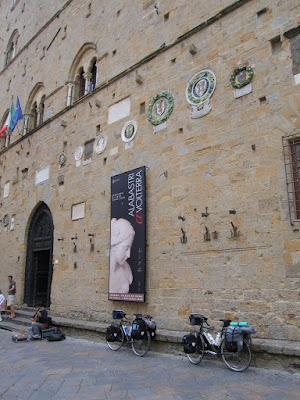Ravenna

Growing up in southern California, we are used to rainstorms that come infrequently, and when they do they pass quickly. But any misconceptions we had about Italy being an arid country have evaporated. We hit a stretch of very wet weather as we headed from Florence to Ravenna. The combination of a persistent weather pattern pumping moisture into the area we were traveling, as well as the orographic effect of the Apennine Mountains, left us soggy.
The Apennine Range form a spine along the length of Italy. Although not particulary high in elevation, it was a challenging ascent due to the weather. The last nine kilometers were a steep, steady climb, and we did it as misty rain fell on us. At the pass we bundled up in all the water resistent clothing we had, and descended into the town of San Benedetto in Alpe. It was late, after 6 pm, and we were ready for dinner and a hot shower. Pulling into the campground, we were greeted by a locked gate. The campground was closed. With no other camping alternatives nearby, we entered into the campground through a small open gate to the side. We wandered around, hoping to attract attention and sympathy to let us camp anyway. It worked -- the proprietor found us, and somehow between her few words of English and John's improving Italian, we settled on a price. Lucky for us, there was a nice gravel plot and cabin with a porch and table and chairs for us to cook. And hot water for showers.
It was a quiet night, but by 4 am it was raining hard. It continued as a torrent for the next four hours, with thunder and lightning for accent. It was obvious we were not going anywhere that day. So we settled in on our little porch, doing mending and crosswords, while episodes of rain continued throughout the day. The afternon cleared, and so did our spirits, as our tent dried and we looked forward to cycling the next day.

Rain returned the next morning just before sunrise. It was a rough night for me, since I was aflicted with a stomach ailment, most likely caused by my sampling of the mouldy rind from the block of cheese we had for lunch (hey, John, this part tastes the best!). We decided to make a break for it, and try to get out of the mountains. Without the help of satellite imagery and weather prediction tools we have via the internet, we were not sure if this is how it always is in these mountains (the local crop is mushrooms, for goodness sakes). So we donned the rain gear once again, and sailed down the winding roads to the flats of the Po River valley.
We had to stop a few times as waves of rain passed through, one time for about an hour and a half under the eaves in the center piazza of the small town of Dovadola. We were a bit of attraction in our saturated state to a group of schoolkids. As I was sitting in my state of nausea on a bench, I could see John's head over a circle of umbrellas. They were very anxious to help us, and drew us a map to a local agriturismo. We ended up pushing on to the town of Forli, where we checked into the Hotel Marta to dry and allow me to recover.
A night in close proximity to a bathroom was helpful, and after a good nights rest we were on the road again. We bought bread at a bakery in Forli, and everywhere the town was alive with vans and booths full of merchandise promoting the Giro d'Italia, the national bike race in Italy. For 10 Euros you get a backpack, t-shirt, stuffed bear, sunglasses, all in bright pink that probably looks great on TV, and is also the color of the jersey of the current race front-runner. Apparently stage 12 of the race was starting from Forli that day, but we headed out of town in a different direction than the racers. Had they been going our way, they surely would have overtaken us -- they cover 200 kilometers in 5 hours, and we did a mere 50 that day.

Pulling into Ravenna we were greeted by one more torrential downpour, be we stayed dry under a roof just outside the city at the Porta Nuova.

Today we toured the city by foot, and it is sunny and dry. The city of Ravenna is known for particulary stunning mosaic art. And tomorrow we cycle on north towards Ferrara and Venice, hopefully with blue skies, flat terrain, and wind to our back.


































